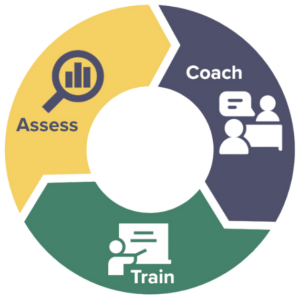This is the first blog in a four-part series designed to help industry decision-makers consider diversity, equity, and inclusion (DEI) issues as they work to build a more diverse workforce and leadership team to accomplish critical business goals.
The rules of business have changed. It’s not enough to be competitive in the marketplace. You must also be a worthy employer that attracts, develops, and retains diverse talent.
Increasingly, employees want to work for a purpose-driven company that provides equal opportunity for all, has a socially good mission or focus, and is willing to stand up and be counted on critical political and social issues. Being purpose-driven is so important that 76% of Millennials interviewed for a survey said they would take a pay cut to work for a socially responsible company. They’re also not afraid to push back against companies that don’t live their values. Employees are using internal message boards, calculated PR leaks, public letters, and even public exoduses to make a statement for what they believe. Social media has democratized advocacy, helping formerly anonymous staff gain a pulpit to speak out on the issues they support.
Employees and Customers Expect Companies to Live Their Values
Examples of this new behavior are everywhere. Software engineer Susan Fowler’s blog post about experiencing sexual harassment at Uber received six million views, resulted in CEO Travis Kalanick’s ouster, and helped drive lawsuits that resulted in a $4.4M settlement to resolve sexual harrassment and retaliation charges. Several Facebook employees have publicly quit over the company’s refusal to police polarizing speech. And increasingly companies are listening: holding forums to allow employees to air their views, announcing policy changes, and publicly publishing new commitments. (One surprising outlier is Coinbase, a cryptocurrency exchange. The company’s CEO told staff they could not take a stand on social issues and offered an exit package for those who disagreed. Some 60 employees to date have taken the deal, voting with their feet.)
These changes are not limited to employees. Customers also want to buy from purpose-driven companies. They’re also not afraid to stand up against or boycott companies when they don’t agree with their policies. Customers have assailed companies such as Goya Foods and SoulCycle for supporting President Trump, as well as called out Heineken, H&M, and others for racist advertising. Meanwhile, entire industries, such as venture capital and private equity, have been called out for being “pale and male,” and not providing sufficient leadership opportunities for diverse talent or access to capital to enough underrepresented founders.
Given the importance of this growing trend as well the velocity of social media, companies can’t ignore or minimize employee or customer needs. So, what can they do?
Recommendation #1: Create a Diverse Workforce that Mirrors the Market
Many industries, such as healthcare, financial services, and retail, are diverse at entry-level positions, but are largely led by white men at higher levels in the organization. Diverse staff often leave firms due to lack of opportunity or pay inequity issues. They may also depart due to the stress of working in environments where no one else is like them.
Hiring a diverse workforce is not as simple as changing the racial or gender composition of an organization. Creating diverse teams includes moving beyond race, color, religion, gender, and national origin, to also include ability and disability, socioeconomic backgrounds, age and generation, thinking styles, personal expression through appearance, work and geographic preferences, and more. Diversity means “the full spectrum of human demographic differences,” finds Gallup.
Companies are implementing a raft of changes to attract candidates: These changes include creating a workforce strategy with quantifiable goals, redesigning recruitment strategies, reconsidering job requirements, developing robust training opportunities, and creating benefits that diverse candidates want and need, among other changes.
Diverse candidates are attracted to purpose-driven companies that are transparent about their diversity, equity, and inclusion (DEI) commitments, where leaders are willing to acknowledge the company’s shortcomings in achieving shared values, and where there is a strong emphasis on not only increasing diversity, but also creating equity and inclusion. That means developing a level playing field where all can flourish and building a culture that fosters teamwork, egalitarian idea-sharing and innovation, and equal rewards.
So, how can a diverse workforce help you understand your customers? In our white paper, Transforming Venture Capital and Private Equity Through Diversity, Equity, and Inclusion (DEI), Lister Delgado, Managing Partner at IDEA Fund Partners says:
“Diversity brings breadth of thinking, when different perspectives come together, and new ideas come into the fold. And so, diversity is not just understanding a particular customer better, it’s about thinking about innovation with a much better perspective, whether that’s product innovation or business models. Diversity touches everything.”
Agrees Karen LeVert, Venture Partner at Pappas Capital, “Diversity is not just black and white. It’s income. It’s rural. It’s city. It’s all of this coming together. So that we have a blend of different experiences that results in a better product.”
Recommendation #2: Begin at the Beginning
Many companies have achieved success pursuing their existing strategies, workforce practices, and talent management model. It can be tempting to believe that these approaches will carry you forward in the future. However, the reality is that they won’t.
Says Chris Heivly, a venture capitalist and SVP of Ecosystem Development for Techstars:
“It’s the same story of AOL versus Facebook, right? Those who adapt and change will stay alive. And those who used to be the king, now they’re barely a prince. They didn’t adapt; they didn’t understand how the world was changing.”
Brandon McCarty, Co-Founder and CEO of CureMint, a dental procurement platform, agrees. As a startup founder, he knows that the actions he takes now will help build a solid foundation for his company, and chief among them is creating a diverse culture that can help his firm grow. Says Brandon McCarty:
“It’s a lot easier to set the foundation for what right is or what you want something to be versus just going and then having to retrain. It’s a lot easier to establish that culture around eight to 12 people and set the baseline and then to begin to add people on top of it, versus have people who might not respect or want to participate in a culture that favors DEI.”
Similarly, understand that individuals who look from the outside in at your culture are making judgments about you that you may not be aware of. Karen LeVert looks at company websites to see how diverse their leadership teams are before considering partnerships.
Recommendation #3: Live Your Values
We live in a polarizing environment where social media can amplify your message, winning fans for life, or quickly turn the public against you. Customers are usually quick to forgive companies and leaders for honest mistakes, especially when they are accompanied by sincere apologies. However, they are less forgiving when they sense hypocrisy.
If your organization wants to form close connections with customers and align your workforce behind your strategy, you must live your values around DEI. It’s fine to be a novice, as long as you make a genuine commitment to DEI and move forward.
Chris Daum, President and Chief Executive Officer of FMI Corporation, has sought help from The Diversity Movement to understand how to drive sustained change. He says:
“We’re taking a very slow and cautious approach because I am not interested in checking a box, writing a check, or putting window dressing on something and saying, ‘There we did it.’ I don’t want the momentum that we’ve built as a response to these tragedies to fade into the distant memory of our firm or any of our employees.”
From the events of 2020, it’s clear that corporate values aren’t abstract concepts designed to languish on company websites or in little-used employee handbooks: They are living, breathing guidelines that employees can follow. Consider creating a values guide that translates values to desired behaviors and provides dos and don’ts as examples. That reduces the guesswork of translating abstractions into daily actions and helps create a more inclusive culture.
To take this recommendation a step further, include your organization’s values into your employees’ development plans, so that they can help your organization progress towards its DEI goals. Of course, it goes without saying that your internal organization should also do the same, so that employees can see the link between your company’s goals and their own.
Across industries, companies are grappling with what it means to live and breathe DEI values. In our whitepaper, we interviewed leading experts from venture capital, private equity, startup accelerators, and startups, to learn how they are building DEI into their cultures. It’s also accompanied by a roadmap that you can re-use for your company, no matter which industry you’re working in.
Get great ideas for driving DEI at your company. Download the white paper.














